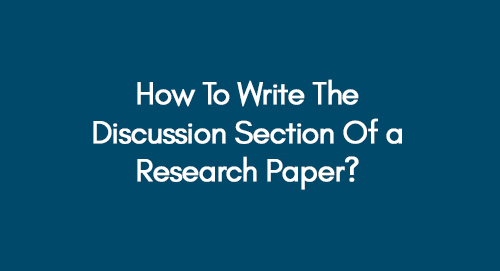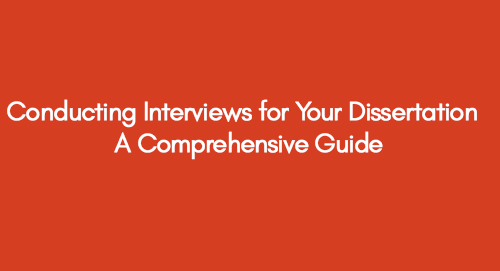
How to Write an Effective Discussion Section in Research? | Expert Tips
October 27, 2022
How to Write an Executive Summary? Scholarly Suggestions
October 27, 2022When it comes to crafting a thesis, the abstract holds the utmost significance as a crucial element. Serving as a succinct overview of the entire thesis, it is vital to possess the knowledge and skills to write an abstract for a dissertation effectively.
Learn the Craft of Writing Stellar Abstracts for Dissertations Here
Explore New Dissertation Topics Here
This proficiency will enable you to provide readers with a clear understanding of the thesis's essence. One must learn the art of how to write an abstract for a dissertation to make their research work stand out.
What is an Abstract?
An abstract is a concise summary of a larger piece of work, such as a research paper, thesis, or dissertation. It provides an overview of the entire document's main points, purpose, methodology, results, and conclusions. The purpose of an abstract is to give readers a clear and brief understanding of the content and significance of the work, allowing them to determine if they want to read the full document. Abstracts are typically written in a structured format and are often limited to a certain word count or character limit.
Discover New Examples of Dissertation and Thesis Here
Explore the Art of Writing an Expert Abstract with Examples Here
Three Simple Steps to Compose a Solid Abstract
Here are the steps for writing a great thesis abstract:
Step One: Know Your Journal’s Requirements
Before you start writing your abstract, you need to know the specific requirements for the journal you want to submit your paper to. Journals have different requirements, so you must familiarize yourself with them before writing.
For example, some journals may have a word limit for abstracts, while others may not. Some journals also require that certain information be included in the abstract, while others may not. Knowing the journal's requirements ensures that your abstract meets them, increasing your chances of getting published.
Step Two: Write a Draft
Once you know what the journal requires, it’s time to start writing your draft. Begin by introducing the problem or question that your paper addresses in one or two sentences. Then, provide an overview of your main findings and conclusion in one or two sentences.
Finally, end with two or more sentences about the implications of your work and any future research that needs to be done. Remember that this is just a draft, so don't worry about making it perfect at this stage. You can always revise and edit it later.
Step Three: Edit and Revise Your Abstract
After you’ve written a draft, it’s time to edit and revise it until you have a final version that you are happy with. Start by reading through your draft and remove any unnecessary words or sentences. Then, check for grammar mistakes and correct them. Finally, make sure that your abstract flows well and is easy to read. Remember to keep within the word limit set by the journal.
Types of Abstracts
There are various types of abstracts depending on the type of information drafted in the text.
1. Descriptive Abstracts
Descriptive abstracts offer a comprehensive overview of a research paper, encompassing its methodologies, findings, and conclusions. This type of abstract is commonly employed for studies involving a substantial amount of data and outcomes. Its purpose is to provide a detailed summary that accurately represents the content of the research paper.
2. Informative Abstracts
Informative abstracts concisely overview a research paper's procedures, findings, and recommendations. They are commonly used for articles with limited results and data. The main objective of an informative abstract is to provide readers with a clear and concise overview of the research paper's key aspects.
3. Critical Abstracts
Critical abstracts critically evaluate a research paper's methodologies, findings, and recommendations. They are commonly employed for argumentative articles or publications that have the potential to be controversial. The aim of a critical abstract is to offer a balanced and thoughtful analysis of the research paper, highlighting its strengths and weaknesses and providing insights into its potential implications and controversies.
Explore Our Amazing Assignment Writing Services Here
Explore How to Write an Abstract for Research Paper Here
Different Methods to Craft an Abstract for Thesis
1. The Traditional Method
The traditional method of crafting an abstract involves writing a summary of your paper. This summary should include the main points of your paper and your conclusions. The traditional way typically requires using formal language and avoiding first-person pronouns.
2. The Inverted Pyramid Method
The inverted pyramid method is a slightly different approach to writing an abstract. With this method, you begin by writing a summary of your paper. However, unlike the traditional method, you follow this summary with a more detailed description of your research and findings. This approach can be helpful if you want to ensure that your readers clearly understand your paper before they read it.
3. The Keyword Method
A strategy known as the "keyword method" focuses on selecting precise keywords that completely define your article. When you've decided on your keywords, you can use them to create a thesis summary. The main ideas from your paper and your conclusions should be included in this summary. Additionally, by including keywords, you can ensure that your abstract is easily searchable on the web.
4. The Question-And-Answer Method
The question-and-answer methodology starts by deciding the most crucial issues your paper will address. Once you have determined the answers to these questions, you can write a synopsis of your work to address them.
5. The Problem-Solution Method
A problem that your thesis will address is first identified using the problem-solution process. Once this problem is discovered, you can provide a summary of your work that details the issue and suggests a potential solution.
Which Information Should be Included in a Thesis Abstract?
Include the following information in your abstract:
- A thesis abstract should include a brief overview of the research conducted in the thesis.
- The research question(s) that were addressed in the research should be included in the thesis abstract.
- The methodology used to conduct the research should be briefly described.
- The results of the research should be summarized.
- The implications of the results.
- The limitations of the study should be acknowledged.
- The future direction of research should be suggested.
- A brief conclusion of the thesis.
Learn More about PhD Thesis Writing Skills Here
Tips to Focus on While Writing an Abstract
These tips will help you write a stellar abstract for your thesis:
1. Keep it Short and Sweet
Remember that an abstract is meant to summarize your work, not a detailed description. As such, it shouldn't be more than 250 words in length.
2. Start with a Bang
The first sentence of your abstract should be attention-grabbing and make the reader want to read on. Avoid starting with dull, generic opening lines such as "In this paper, I will be discussing..."
3. Get to the Point
An abstract's primary goal is to provide the reader with a summary of your work. It should only include the most important information about your thesis. Save the details for the body of your paper.
4. Use Keywords
Choose 1-2 keywords that accurately describe the content of your thesis and include them in your abstract. It will help ensure that your work comes up in relevant searches.
5. Proofread
Once you have written your draft, set it aside for a few hours (or even a day) and then come back to revise it with fresh eyes. Be sure to edit carefully for grammar and spelling errors.
By following these tips, you can write an effective abstract that will pique the reader's interest and provide them with a good sense of your thesis.
Discover More About Beginner's Guide on Restating Thesis Here
Conclusion
An abstract is important to any thesis paper - don't overlook its importance! Following the tips outlined in this guide, you can write an effective abstract that will grab the reader's attention and give them a good idea of your thesis.
Writing an abstract can seem tough sometimes, but it doesn't have to be! By following these simple steps on how to write an abstract for a thesis—you can make the process easy and painless. So don't delay; start writing that perfect research paper today!
Explore more on how to write an abstract
Contact Premier Dissertations to help craft the perfect abstract for your thesis.
Get an Immediate Response
Discuss your custom requirements with our writers
Free Online Plagiarism Checker For Students
We will email you the report within 24 hours.
Upload your file for free plagiarism





























